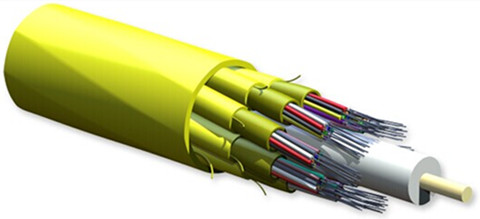As the system bandwidth increases, local area network (LAN) campus and building backbones as well as data center backbones are migrating to higher cabled fiber counts. Cable options like loose-tube cable and tight-buffered cable appear for the applications. Later ribbon cable come into the market to meet this need, as they provide the highest fiber density relative to cable size, maximize use of pathway and spaces, and facilitate ease of termination. The following will talk about these kinds of cables.
Loose-tube cable allows the fibers to lie freely within dry buffered tubes inside the jacket. Because the fibers are loose and not bonded in a ribbon matrix, they do not exhibit any preferential bend and can be flexed in any direction with significantly reduced risk of damage relative to the ribbon cables. Loose-tube cables are much more flexible over the tight bends in the concentrated pathways found in the data center environment.
Loose-tube cable is an design for the LAN applications especially when there are hash environment conditions in outdoors. Many loose-tube cables contain a water resistant gel surrounding the fibers. The gel is good to protect the fibers from moisture, making the cables ideal for high humidity environments. It also enables cable to expand or contract with temperature changes. Loose-tube cable protect the fibers from outside environmental and mechanical damages. That’s why loose-tube cables are widely used in outdoor environments.
Meanwhile, there are tight-buffered cables for indoor use. Compared with loose-tube cables, they are better suited for moderate length LAN or WAN connections. Tight-buffered cables offer flexibility, direct connectability and design versatility necessary to satisfy the diverse requirements existing in high performance fiber optic applications.
Instead of using the gel layer, tight-buffered cables have a two-layer coating, plastic and waterproof acrylate. The acrylate keeps moisture away from the cable. Tight-buffered cables are easier to install, because there is no gel to clean up and it does not require a fan out kit for splicing or termination.

This cable is called ribbon cable because of the looks. It contains a lot of conduction wires lined up side-by-side, to create flat, wide cabling, which resembles a ribbon. The cable design characteristically consists of 12 to 216 fibers organized inside a central tube. It can provide the highest fiber density relative to cable size, maximize use of pathway and spaces, and facilitate ease of termination. Ribbon cables are ideal for situations where space is a factor because they lay flat and take up very little room. This kind of cables have emerged as a primary cable choice for deployment in campus, building, and data-center backbone applications where fiber counts of more than 24 are required.
But the 12-fiber ribbon field terminations was limited. So the innovations such as ribbon-splitting tools, ribbon-furcation kits, and field-installable 12-fiber array connectors were introduce. Then 12-fiber ribbons can be easily terminated with simplex and duplex connectors (such as LC or SC type) or with the MTP array connector. The MTP connector is a 12-fiber push/pull optical connector with a footprint similar to the SC simplex connector. These high-density connectors are used to significantly accelerate the network cabling process, minimize errors, and reduce congestion in patch panels. MTP connectorized ribbon cables allow installers to reduce installation time, minimize clutter and maximize the rack space.

All in all, it’s very essential to maximize the use of pathway and spaces, especially in campus and data center backbones. The above cables such as loose-tube cable, tight-buffered cable and ribbon cable play obvious roles for space savings. Fiberstore offers all of these cables and each one has different types of cables. There are also customized service such as optional fiber counts, cable types and lengths etc. So you must choose appropriate one for your network here.